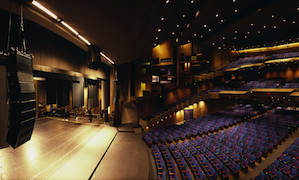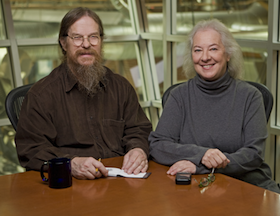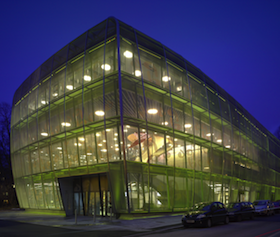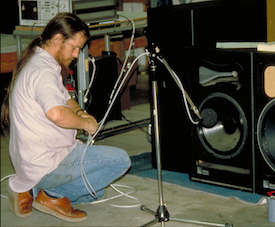
Does it represent the new paradigm of concert hall sonics, or does it spell the death of “live” acoustic sound as we have grown to know it? The answer, as it turns out, is hardly as black and white as the question implies. But one thing is certain: In less than a decade, Meyer Sound’s Constellation Acoustic System, a flexible, digitally based, acoustic enhancement system that was birthed in Berkeley and Canada, has transformed both our understanding of what is possible within the confines of the concert hall environment, and the nature of those environments themselves.
Constellation, in the company’s own words, is:
“a complete solution of equipment and services … that enables the acoustical properties of a room to be altered to suit the nature of the event taking place. Constellation is provided as an integrated solution that includes on-site evaluation, supervision, and final tuning… Once Constellation is commissioned, the acoustical properties of [a] venue can be optimized with the press of a button.”
That optimization is about far more than the sound that reaches the ears of audience members. John Pellowe, project director for Constellation, emphasizes that there are four essential criteria that the system must satisfy:
“One, the audience has to hear the performers. Two, the performers have to hear each other. We use Constellation to make communication across the stage a much more satisfying experience for musicians. Three, the performers need to hear the audience. This is often forgotten in the design of buildings. To top it all, the audience needs to hear each other, so that when they applaud, they’re not applauding into an acoustic black hole, but rather into the same kind of reverberant space that the performers are making music in.”
While you would certainly expect Pellowe to have nothing but good things to say about their electronic enhancement system, it’s important to note his credentials. A recording engineer for Decca during the so-called “Golden Era of Recording,” from the mid-1970s through 1996, he worked first in London, then in Vienna with conductor Georg Solti. From there he went to the U.S., where he worked with the Chicago Symphony with Solti, the Cleveland Orchestra with Dohnányi and Ashkenazy, and later on with the San Francisco Symphony and Blomstedt and the Metropolitan Opera Orchestra with Levine.
In 1995, Pellowe became sound engineer for Luciano Pavarotti and the Three Tenors, and worked with the tenor until the end of his career. Given that 90 percent of the Three Tenors’ concerts were amplified with Meyer Sound equipment, he and Pavarotti began a relationship with the company that, for Pellowe, continues to this day.
“A question that often comes up from people thinking about Constellation is if it sounds natural,” Pellowe told me via Skype.
One response to that, which I feel is quite legitimate, is that the only natural acoustics that I’ve ever come across are probably caves. If you look at all our other acoustic spaces, they’re all human-made, and they’re made of wood or plasterboard, metal, concrete, and all those other things.In that respect, I think the way Constellation works is entirely natural. It’s doing exactly the same thing that those physical materials would do. It’s adding or returning early reflections and reverberation back into the room.
“The way Constellation works is entirely natural. It’s adding or returning early reflections and reverberation back into the room.” — John Pellowe, Constellation
Musical instruments are acoustic in their own right. A violin, for example, has its soundbox. A fantastic acoustic will couple with that instrument to give its sound the envelopment and immediacy that we all love. Constellation does exactly that. If you can tell that it’s Constellation that has produced the envelopment and reverberation, rather than something the instrument interacting with the acoustic, then we have basically failed. The system must be entirely natural and transparent so that artists who are not told about it don’t really know that it’s there.
Pellowe audaciously asserts that he believes that Constellation can create an acoustic better than the best physical spaces we now have. He points out that, as fabled as several renowned halls' acoustics may be, the sound in the Musikverein’s loges, or underneath the balcony at the Concertgebouw, is “pretty rotty.” As for Davies Symphony Hall, not only is the sound poor in the First Tier and toward the rear of the orchestra, but, according to Pellowe, the hall also provides a different acoustic experience to the audience than to the performers.
With Constellation, we can create good acoustics throughout the building so people can have good sound wherever they’re sitting. We actually change the acoustic of the building by means of microphones, very sophisticated digital technology, and loudspeakers, all of which are very linear and smooth in their operation. We don’t add gain to the building, or increase the level any more than you might if you made the room very live in the first place.
Hometown Tryout

The first public concert hall equipped with the Constellation Acoustic System was the concrete shell known as UC Berkeley’s Zellerbach Hall. Serving as the main home of Cal Performances, perhaps the nation’s most prestigious multi-discipline concert series west of Manhattan, Zellerbach is but one of a host of concert halls built in California without regard for acoustics. (L.A.’s Dorothy Chandler Pavillion and Cupertino’s Flint Center are others.)
Since its inauguration in 1968, Zellerbach has hosted everything from dance performances accompanied by live or canned music, theatre, opera, symphony, solo and chamber concerts, and amplified jazz, pop, and world music. Yet, its inherently dry and minimally reverberant acoustic was far from ideal for most of those, until the installation of a Constellation system.
Sometime in 2006, after John and Helen Meyer had installed Meyer Sound’s first Constellation system in their company’s intimate and intentionally dry Pearson Theatre in Berkeley, they invited Cal Performances’ former mastermind, Robert Cole, to hear a string quartet performance with and without Constellation activation. At the time, Cole had been considering a structural acoustic makeover for Zellerbach whose projected cost was between $30 and $50 million.
“I told him we could do it cheaper than that,” John Meyer recalls. “I also pointed out that the problem with his fix was that a classical acoustic wouldn’t work for rock and pop. Instead, we came up with different electronic settings for different kinds of music.”
“The fact about Constellation that’s appealing is that you don’t know that it’s happening. That’s the whole point, of course.” — Mark Morris, choreographer
The first time Cal Performances used the Constellation System was for its star-studded 100th Anniversary Celebration on May 12, 2006. According to John Meyer, “Zellerbach initially had it for a one-night demo and they wouldn’t let us take it out until, after a few years, they bought it. But until it was theirs, we brought in a lot of people to hear what it could do.”
Within a year, Meyer Sound had also installed Constellation in the 99-seat Covina Center for the Performing Arts. Since then, the number of Constellation installations has grown to 53. Venues include the 2068-seat ASB Theatre at the Aotea Centre in Auckland, New Zealand; the Jacqueline and Peter Hoefer Auditorium at Berkeley’s Crowden School; the 1734-seat Svetlanov Hall at the Moscow International House of Music; the 3500-seat Logomo in Turku, Finland; the 450-seat MUMUTH Theatre at the the University of Music and Performing Arts in Graz, Austria; and the private Villa Phoenicienne in France.
Several well-publicized installations, including those in Berkeley’s Comal Restaurant/Bar/Club (which enabled patrons to hear each other for the first time) and various Cirque du Soleil sites, have attracted international attention. As a result, the Meyers estimate that their 330 employees, headquartered in various offices around the world, are currently working on at least 10 if not more than 20 new Constellation installations.
The Proof of the Pudding…
Many have questioned the efficacy of Constellation in Zellerbach. When Matias Tarnapolsky, Cole’s replacement as Cal Performances head honcho, arrived in Berkeley, he was none too happy about working in a Constellation-equipped hall.
“When it was initially described to me, I didn’t believe it could possibly work,” he confesses. “When I heard it, all my doubts went away. Constellation has uniformly improved the sound and acoustic in Zellerbach Hall. I really do believe in the system; it really has helped Zellerbach immensely.”

I, too, admit to a healthy skepticism when it comes to electronic enhancement. Perhaps anticipating my concerns, the Meyers and publicist extraordinaire Karen Ames invited me to their Pearson Theatre to hear a star-studded quartet composed of San Francisco Symphony musicians. Treated to the same kind of demo that opened Robert Cole’s ears, the differences with and without Constellation were, to say the least, startling. Most convincing was my own experience whistling onstage, and discovering how different, wetter and more engaging my “voice” sounded to me depending upon the degree of enhancement. I was certainly most comfortable whistling with the system maximally engaged.
On a subsequent visit to the Meyer Sound complex, I spoke by phone with a beloved Cal Performances favorite, choreographer Mark Morris.
I work with live music exclusively, and I have for many, many years, in halls all over the world. I don’t care if they say ‘we had the best acousticians in the world come in to do this,’ because the job of acousticians is the biggest joke in the world when they tell people it sounds great and it sounds horrible. It doesn’t matter to me if it’s a placebo or an actual cure. I only care if it sounds good.I am compelled, because of the size of American theaters, to work in big venues, but my preference and budget have me dancing to chamber music [such as] a Bach Cello Suite, where the sound is a big problem. What do you do, because people have to be pleased? Either you do something in a small hall that suits it, when it’s un-American to charge $500/seat, or you do the democratic version from the ‘60s and ‘70s, and perform in a 2000 to 3000-seat theater which is not acoustically balanced, as is the case with the brutalist architecture of Zellerbach.
I only allow any kind of amplification or sound sweetening in my shows to enable people to hear it undistorted in a big hall. It doesn’t have to sound like shit, as do the Broadway aesthetic or the terribly amplified sound at the Met in amplification-specified operas.
John and Helen had a lot at stake when they allowed me to decide if I would employ the Constellation system for my opera, King Arthur, a while ago. The fact was that I liked it very much and allowed it to be used.
“What they’ve done with Zellerbach is almost miraculous. When I played there onstage, I could hear all the strings as well as the winds and brass.” — Rene Mandel, Berkeley Symphony
The Met doesn’t know how to do it, but the Meyer people do, and that’s why it works. The worrying and horrors they have to go through in figuring this thing out is a wonderful payoff, because it really works in an astonishing way. The fact about Constellation that’s appealing is that you don’t know that it’s happening. That’s the whole point, of course.
Among other Constellation fans eager to supply testimony for this article was Berkeley Symphony Orchestra violinist Rene Mandel. Currently Executive Director of the Berkeley Symphony Orchestra, Mandel performed in Zellerbach as the symphony’s Principal Second Violin on many occasions.
“What they’ve done with Zellerbach is almost miraculous,” says Mandel. “When I played there onstage, I could hear all the strings as well as the winds and brass. Even in Weill Hall in Sonoma State’s Green Music Center, you may not be able to hear your colleagues when you’re onstage.
“At our last concert, the Meyers were experimenting with the system on and off. The difference was so striking it was virtually startling. When the system is on, you feel like you’re in an actual dedicated concert hall, not some multi-purpose venue.”
Creating the Future
“We are ever evolving Constellation,” says John Meyer. “With the electronic world, we can move beyond the physical world. When the Vienna Philharmonic people first came to Berkeley, they told us that they liked the sound in Zellerbach better than their own Musikverein. We are changing the paradigm. It may take a long time for the physical people to give up their attachment, but we can do a better job with our electro-acoustics. We can study and refine our system, creating different acoustics for different performing situations, and stay ahead of the envelope.”

Last year, for example, Meyer Sound discovered that they could capture the “cathedral” acoustic of a mosque in the Middle East, encode it on a USB stick, and import / custom tailor it to other venues as desired. With that came a newfound ability to personalize systems for individual users. One of their current projects involves simulating, in a large venue, an acoustic shell that recreates the sound of a solo violin in an intimate venue.
Pellowe states that one of their recent discoveries is a way to give halls a long reverberant tail, yet retain “amazing” clarity. Meyer Sound is currently revisiting halls to implement re-tunings. If this comes to pass in Zellerbach, I look forward to discovering if the welcome detail I experienced when, at a recent Brahms Revisited concert by Anne Sofie von Otter and Emanuel Ax, I moved up five rows in the orchestra, will now be available in my original seat farther back in the hall.
“We are constantly improving our systems, and making things easier to operate,” says Helen Meyer. “When Herbie Hancock came here, we showed him the Spacemap program that we developed for Cirque to move voices and images around the room, many at the same time. After Herbie heard it, we set up his one-man show in Bing Concert Hall at Stanford where he used 10 iPads to move sounds around the room. Then we added Spacemap to a high school system in Texas.
“Now we ask presenters if they want to install a system that attracts people like Herbie Hancock. We also work with various composers through the Berkeley Symphony and the Exploratorium. Bob Weir, formerly with the Grateful Dead, has a Constellation system that he’s composing to in the studio of his Tamalpais Research Institute (TRI) in Marin.” (See more on Weir's current projects.) Weir has worked with the Meyers since 1980, when John convinced The Grateful Dead to both install their fabled high quality sound system, and also allow fans to record their concerts.
In an age where personal listening habits are rapidly shifting from shared acoustic experiences in concert halls and on home stereos to amplified everything and private listening via iPhones and earbuds, Constellation may in fact prove both a bridge to the future and a saving grace for classical music. Given its success, it’s certain that the Meyers’ Constellation will continue to expand far beyond Planet Berkeley.
